The purpose of this document is to provide an identification guide for Cannabis sativa to be used by growers and land managers by showing key factors to distinguish it from similar-looking plants. The general public and aspiring botanists may also use this document to see how a plant is defined botanically and how those characteristics can distinguish a plant of interest from other look-alike plants.
Cannabis, Hemp, Marijuana, Pot, Weed
Cannabis sativa L. from the family Cannabaceae is a highly recognizable plant the world over. Native to central Asia, it evolved with some of the earliest human civilizations and has since distributed globally, where it grows in both wild and cultivated settings (Tancig et al. 2021). Cannabis sativa is commonly known as cannabis, hemp, marijuana, pot, or weed. The palmate, deeply sharp-lobed leaves are distinctive and often used in popular art and culture. It can be grown for fiber, seeds, and flowers, then further processed into biomass, oils, and chemical compounds called cannabinoids and terpenes (Kaur et al. 2021). Cannabis is naturalized in Florida, but finding naturalized populations of cannabis in Florida may be challenging (Wunderlin et al. 2023; Franck, UF Herbarium, personal communication 2023). The weed risk assessment by UF/IFAS indicates a high risk of invasion into natural areas; this could be facilitated by escape from cultivation (UF/IFAS 2018). Caldazilla et al. (unpublished data 2023) found that it needs recently tilled (disturbed) soil to seed itself in the Krome gravelly loam (rockdale) soil of south Florida. Hence, cannabis may be encountered growing uncultivated in Florida, but it may be limited to tilled areas.
Many governments have ruled cannabis a prohibited plant. However, recent changes in laws have established legal pathways for possession and cultivation in some places. In the United States, hemp is distinguished from marijuana by the content of its delta-9-tetrahydrocannabinol (THC). Hemp does not exceed 0.3% THC, while marijuana is legally 0.3% THC or higher. This legal definition requires a lab test to measure the THC level once a plant is identified as cannabis. This publication describes how to botanically identify cannabis and provides tips to distinguish it from other plants.
Because hemp and marijuana are legally distinct and variably regulated, growers, land managers, and the public should know how to distinguish cannabis from other plants. Below are details used by botanists to characterize Cannabis sativa (Wunderlin et al. 2023; Kew Royal Botanic Gardens 2023; Verdcourt 1975).
Growth habit: Herbaceous or suffrutescent (semi-woody) upright herb with mature heights 0.3–3 m; most plant parts are pubescent; varieties grown for different uses often vary greatly in size, with seed and flower varieties typically shorter than fiber varieties.
Leaves: Alternate or opposite, palmately compound; 5–18 cm long × 3–18 cm wide; petioles 3–8 cm.
Leaflets: Usually 3–7 leaflets but up to 11; each 3–18 cm long × 0.3–3 cm wide, sessile, narrowly lanceolate, elliptical, or linear with long-tapering tips and bases; margins coarsely toothed (or serrated) with prominent pinnate veins and midribs.
Inflorescence: Imperfect (male or female), plants monoecious or dioecious.
Male flowers: In loose panicles to 18 cm long; whitish to yellow-green, with the sepals oblong-elliptic and 2.8–4 mm × 1–1.6 mm.
Female flowers: Compared with males, female inflorescences are shorter, more compact, and fewer-flowered; a small leaflike bracteole 2–9 mm long encloses each flower or fruit.
Fruit: Achene; a single dry seed (2.5–5 mm × 2–3.5 mm) covered with a thin papery wall (the leaflike bracteole).
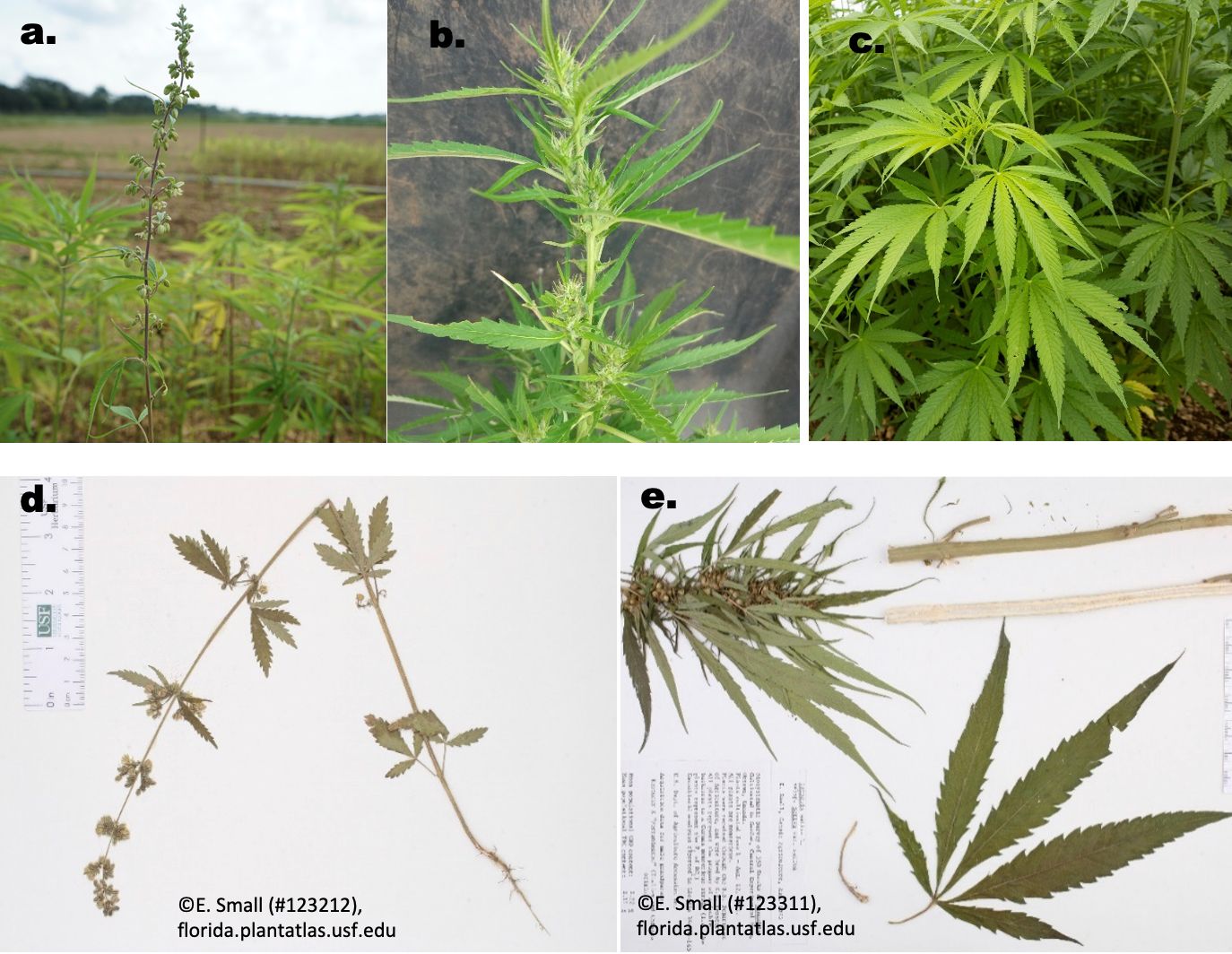
Credit: a.) Tamara Serrano; b.) Cliff G. Martin; c.) Taylor Jones; d.) E. Small, florida.plantatlas.usf.edu; e.) E. Small, florida.plantatlas.usf.edu
Similarities and Differences of Cannabis Look-Alikes, Including Habit, Leaflets, and Flowers
Below are descriptions of plants with many botanical similarities to cannabis. Some features may render them difficult to distinguish from cannabis, such as having serrated, palmately compound leaves. However, under careful scrutiny, differences do appear between cannabis and plant species with similar growth habits, leaf shapes, and flowers.
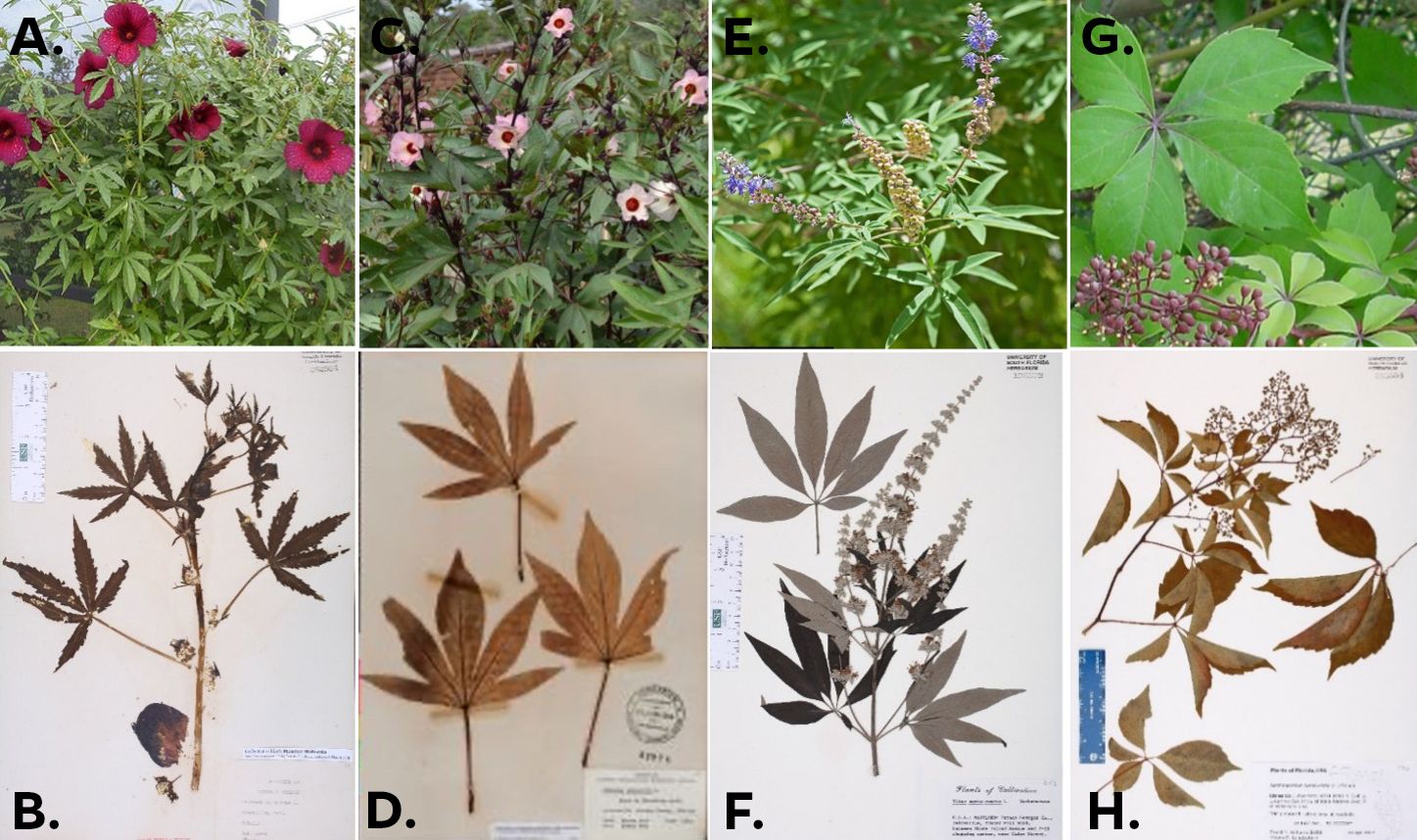
Credit: A.) Khartasia. B.) M. Mulvania, plantatlas. C.) © Claude Boucher Chisale, africanplants. D.) Erdman West, UF Herbarium. E.) © Keith Bradley, plantatlas. F.) S. R. Hill, plantatlas. G.) © Allen Boatman, plantatlas. H.) D. H. Williams, W. D. Longbotto
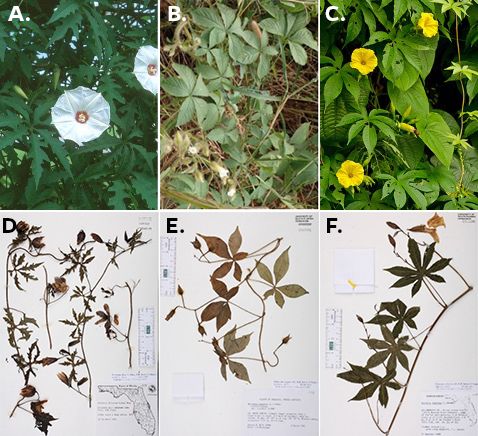
Credit: A.) © Roger Hammer, plantatlas. B.) Sylvain Piry, africanplants. C.) © Keith Bradley, plantatlas. D.) © E. Stere, D. Hatten, plantatlas. E.) © S. R. Hill, L. R. Phillippe, plantatlas. F.) © S. Dickman, C. Campbell, T. J. Weekes, plantatlas
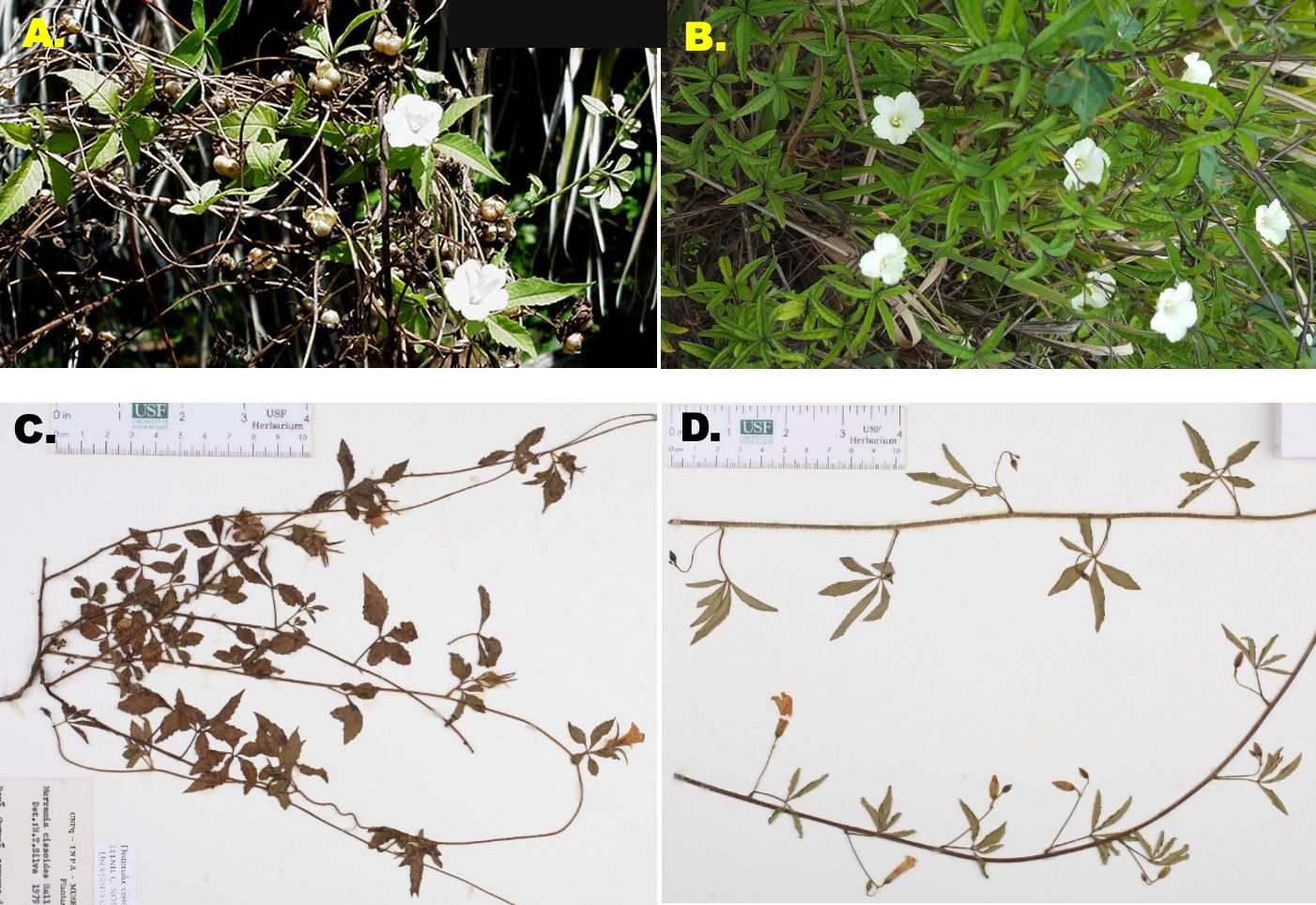
Credit: A.) © Patricia Howell, plantatlas. B.) Rafaël Govaerts, Kew Royal Botanic Gardens. C.) © N. T. Silva, C. Rosário, plantatlas. D.) © K. A. Bradley, plantatlas
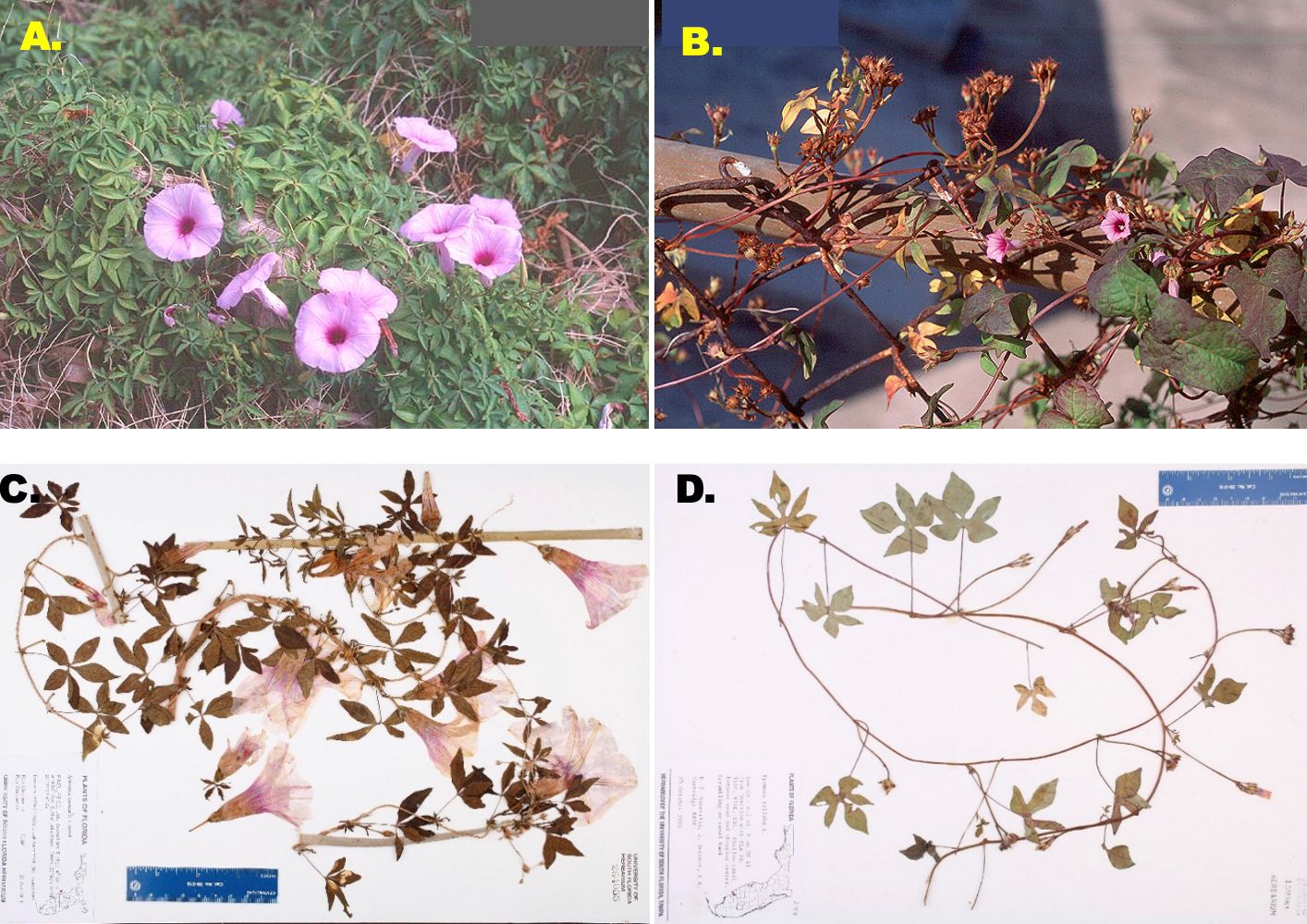
Credit: A.) © Betty Wargo, plantatlas. B.) © Betty Wargo, plantatlas. C.) © R. Chicone, R. Wunderlich, plantatlas. D.) © R. P. Wunderlin, J. Beckner, A. Partridge, plantatlas.
Further Reading
An effective technique for identifying cannabis and its look-alikes involves using botanical keys to first determine the plant species and then comparing it with online herbarium specimens. A guide on how to use a botanical key is Ask IFAS publication ENH1249, “How to Use a Dichotomous Key: A Tutorial Featuring 10 Common Shade Trees of the Tampa Bay Area” (Koeser et al. 2018). Guide to the Vascular Plants of Florida (Wunderlin and Hansen 2011) is a book with keys for identifying cannabis and all other plant species that grow without cultivation in Florida, including many of its look-alikes, and an excellent glossary of botanical terms. Online herbarium specimens can be viewed at the Atlas of Florida Plants (Wunderlin et al. 2023) and the Florida Museum Herbarium Collection (Franck et al. 2023). The former website has only plant species established in Florida, while the latter website also includes species known only from cultivation, such as Hibiscus sabdariffa. Plant specimens can also be submitted to professional botanists for identification using instructions given by the UF/IFAS Plant Identification and Information Service; the form is available at https://edis.ifas.ufl.edu/publication/sr024 (Williams and Frank 2021). Evaluations of invasiveness of non-native plants in Florida’s natural areas may be found at https://assessment.ifas.ufl.edu/assessments/ (UF/IFAS 2023). Based on this invasiveness evaluation, UF/IFAS faculty and staff do not recommend plant species with high invasive potential, including hemp.
References
Dressler, S., M. Schmidt, and G. Zizka. 2024. “African Plants - A Photo Guide.” Forschungsinstitut Senckenberg, Frankfurt/Main, Germany. Accessed March 4, 2024. www.africanplants.senckenberg.de
Franck, A., K. Perkins, S. Haas, and P. Caplan. 2023. “Florida Museum Herbarium Collection.” Gainesville: University of Florida, FLMNH. Accessed August 30, 2023. http://www.flmnh.ufl.edu/herbarium/cat/catsearch.htm
Kaur, N. G., L. K. Sharma, C. Kelly-Begazo, M. Tancig, and Z. T. Brym. 2021. "Uses of Raw Products Obtained from Hemp: Fiber, Seed, and Cannabinoids: SS-AGR-458/AG459, 9/2021." EDIS 2021 (5). https://doi.org/10.32473/edis-AG459-2021
Kew Royal Botanic Gardens. 2023. "Plants of the World Online (POWO)." Accessed August 30, 2023. https://powo.science.kew.org//taxon/urn:lsid:ipni.org:names:77163286-1
Khartasia. 2023. Khartasia Paper Co., University of Paris, France. Accessed August 30, 2023. https://khartasia-crcc.mnhn.fr/fr/content_fr/hibiscus-cannabinus-l
Koeser, A. K., G. Hasing, M. G. Andreu, and M. H. Friedman. 2018. "How to Use a Dichotomous Key: A Tutorial Featuring 10 Common Shade Trees of the Tampa Bay Area." ENH1249. Gainesville: University of Florida Institute of Food and Agricultural Sciences. https://edis.ifas.ufl.edu/ep510
Tancig, M., C. Kelly-Begazo, N. G. Kaur, L. K. Sharma, and Z. T. Brym. 2021. "Industrial Hemp in the United States: Definition and History: SS-AGR-457/AG458, 9/2021." EDIS 2021 (5). https://doi.org/10.32473/edis-AG458-2021
UF/IFAS. 2023. "Assessment of Non-Native Plants." https://assessment.ifas.ufl.edu/assessments
Verdcourt, B. 1975. Flora of Tropical East Africa: Cannabaceae.
Williams, N. H., and M. S. Frank. 2021. "Request for Plant Identification." RFSR024. Gainesville: University of Florida Institute of Food and Agricultural Sciences. https://edis.ifas.ufl.edu/publication/sr024
Wunderlin, R. P., and B. F. Hansen. 2011. Guide to the Vascular Plants of Florida, Third Edition. Gainesville: University Press of Florida.
Wunderlin, R. P., B. F. Hansen, A. R. Franck, and F. B. Essig. 2023. “Plantatlas,” or “Atlas of Florida Plants.” [S. M. Landry and K. N. Campbell (application development), USF Water Institute.] Tampa: Institute for Systematic Botany, University of South Florida.
Herbarium specimens: http://florida.plantatlas.usf.edu/Specimen.aspx; Photos: http://florida.plantatlas.usf.edu/browse/photos